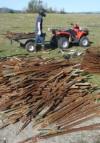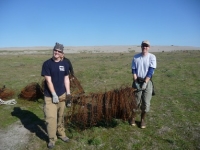 Cleanup at Former Caspian Tern Colony in the Columbia River Estuary
Cleanup at Former Caspian Tern Colony in the Columbia River Estuary
Back during 1999-2001, regional resource managers sought to relocate Caspian terns that were nesting on Rice Island, a dredged material disposal site in the Columbia River estuary, to East Sand Island, closer to the river mouth, in order to reduce their impacts on survival of juvenile salmonids. To accomplish this task, they erected silt fencing as a nesting deterrent on a large portion of the colony area used by the Rice Island colony. The good news is that these efforts contributed to the successful relocation of nesting terns from Rice Island to East Sand Island in less than 3 years (thereby reducing their consumption of salmonids by more than 50%), but the bad news is that all of those materials remained on Rice Island and were no longer serving any purpose (the former tern colony site is now completely vegetated and therefore unsuitable for tern nesting).
With the help of NOAA Fisheries, Pacific States Marine Fisheries Commission, and the U.S. Army Corps of Engineers, Bird Research Northwest led an effort to clean up the old Rice Island tern colony site (located near Astoria, Oregon) on October 14, 2010. Thirty-four smiling faces met at the Tongue Point boat ramp early Wednesday morning and, due to rough water, endured a wet boat ride out to the island. Luckily the sun was out to dry us off before beginning the work to pull roughly 2,000 metal t-post from the ground, roll up miles of fencing wire, and gather up thousands of pounds of old silt fencing, tires, and other debris left on the old colony site. This task was made a whole lot easier by NOAA Fisheries, which provided two ATV’s to haul materials from the colony site to the shore and a small barge to take everything off the island. In total, over 15,000 lbs of debris were removed from Rice Island. Thousands of metal, fiberglass, and wooden posts were salvaged and stored for later use. The fencing wire, damaged metal fence posts, and rebar were taken to a recycling center and the silt fencing and other non-recyclable debris were taken to the landfill. All and all a very satisfying accomplishment that was long overdue.
 |
- Ken Collis (RTR)



